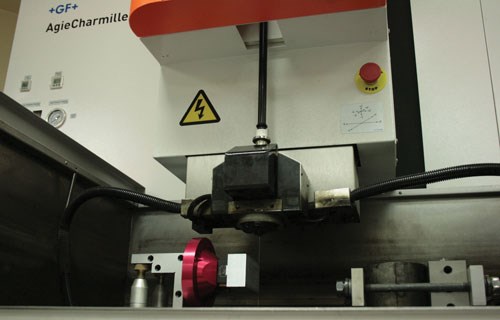When Steve Grangetto and Chris Taylor founded 5th Axis Inc., they were already familiar with the complexities inherent to the technology that inspired the name of their new machine shop. Lacking a five-axis learning curve enabled the co-CEOs to turn their attention to automation relatively early in the company’s history, and before long, they had installed the first of three Mikron HSM 400U five-axis machines from GF AgieCharmilles (Lincolnshire, Illinois) with integrated pallet systems. However, addressing an unexpected snag with finding suitable fixturing for the new system required designing a new line of custom dovetail workholding devices—products that proved successful enough in-house to introduce to the wider market. Today, the very machining systems that drove the shop to develop those fixtures play an important role in producing them cost-effectively.
Mr. Taylor and Mr. Grangetto are both mechanical engineers with backgrounds in machining, engineering and automation. With a common goal of standardizing on five-axis technology to improve machining efficiency, they purchased their first basic-model machine in 2005. The gambit paid off: Within a year, 5th Axis had attracted enough business to move into its current 20,000-square-foot facility in San Diego, California.
Automation has been a key factor in the shop’s growth, the co-CEOs say, and the Mikron machines include all the necessities for lights-out operations. In addition to being designed for high speed and precision, the machines shipped with features such as probes, laser tool measurement, tool-breakage detection and more already included. This enabled the shop to avoid the headaches associated with integrating separate, aftermarket systems. However, finding the right fixtures for the accompanying pallet systems proved more difficult than they had anticipated. “We had all of these pallets and no way to hold our parts,” Mr. Taylor recalls.
At first, vises seemed like the most viable option. However, the cost of purchasing enough vises to fill the pallet pool was prohibitive, he says. In addition, few available models offered both sufficient clamping power and a design that would not create tool-clearance issues, which can be especially problematic for five-axis operations. The shop decided to develop its own custom fixtures, and research eventually led to the conclusion that a dovetail design would best meet requirements.
Known as one of the strongest structural joints in terms of tensile strength, dovetails are especially useful for the high speed, multi-axis machining that is common at 5th Axis, the company’s co-CEOs say. Their particular design is machined from hardened alloy steel and grips parts via corresponding 45-degree angles machined into the workpiece stock and the fixtures themselves. This configuration provides five-axis machine spindles with access to all five faces of the workpiece to eliminate the need for additional setups.
Today, the shop uses these fixtures for approximately 90 percent of its work. Having been developed for 5th Axis’ own needs before being introduced to the market, the fixtures’ design reflects the shop’s familiarity with concerns that make many manufacturers hesitant to use dovetail workholding. For example, the fact that the fixtures can clamp onto as little as 0.06 inch of material reduces the time and expense associated with prepping the workpiece stock for gripping, Mr. Grangetto says. Likewise, the ability to use smaller stock than what a traditional vise could accommodate can reduce material costs, especially when working with expensive materials such as titanium, molybdenum, tungsten and high-temperature alloys.
Another common complaint is that dovetail end mills are expensive and require frequent replacement when cutting hard materials. For that reason, the shop created a custom dovetail cutter. Made from H13 tool steel and featuring a 1-inch-diameter shank that fits set-screw, collet or shrink-fit holders, the tool uses V-type inserts that can be replaced as-needed. “Now, we simply replace inserts and not $200 end mills,” Mr. Grangetto says.
The co-CEOs add that increasing part density was a major driver in the fixtures’ development. Their modular design and small footprint enable users to mount large numbers of parts, whether on a three- or five-axis machine or a horizontal tombstone. “We can easily fit 20 or more parts onto each face of a tombstone or small three-axis table,” Mr. Grangetto says. “The fixtures allow us to run lights-out without worrying about throwing a part.”
In fact, one important lights-out application of the fixtures at 5th Axis is the creation of other fixtures. “We actually make dovetail fixtures using our dovetail fixtures,” Mr. Gangretto says. Fittingly, most are mounted on pallets for machining on the Mikron HSM 400U machines. Smaller models, such as 0.5- by 0.5-inch micro-dovetail fixtures, require operations on the shop’s GF Agiecharmilles Cut 20 wire EDM. The dovetail fixturing system has also been fully integrated with that machine, and with repeatability of 0.001 inch, the fixtures’ precision locating pins enable the shop to move parts seamlessly between the EDM and the machining centers.
Mr. Gangretto adds that although the production process for the dovetail fixtures showcases their design advantages, pairing them with the right equipment is just as important. The Mikron machines, he explains, cut the fixtures from heat-treated, 42-HRc steel more accurately and twice as fast as previously used models. As a result, the shop has decreased scrap and shortened delivery times—benefits that apply to its own operations as well as those of its customers.








































